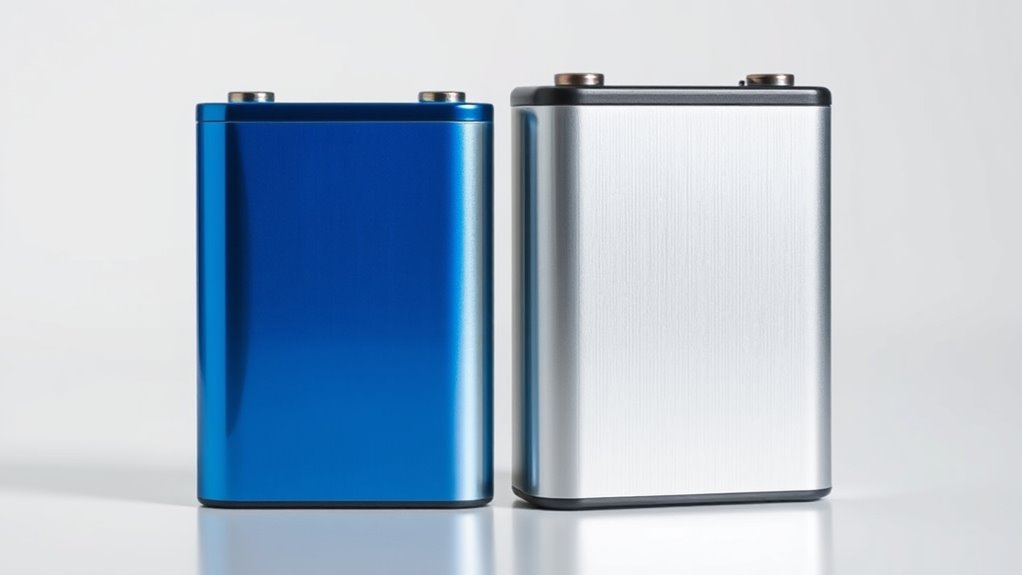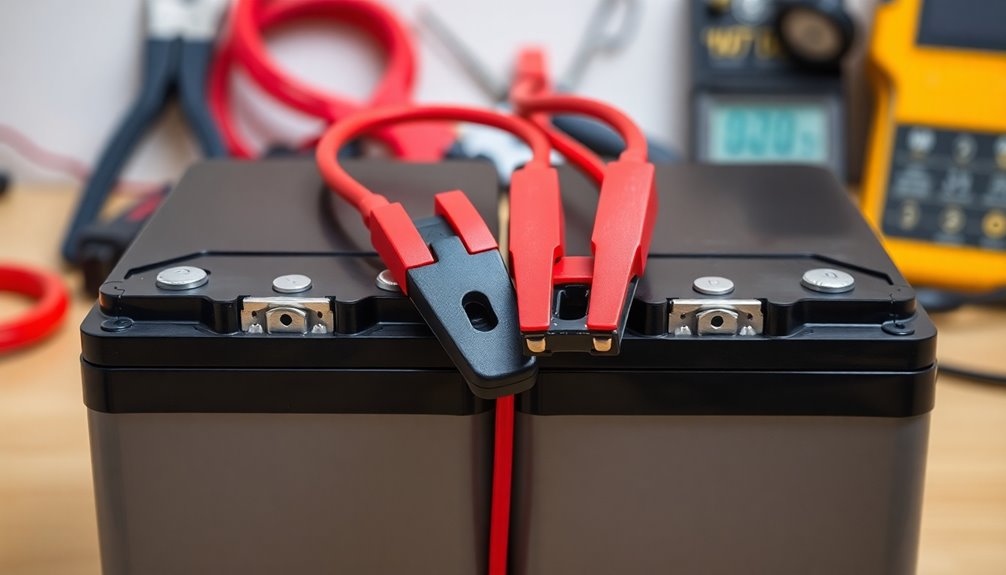Energy density matters because it determines how much energy your battery can store in a given size or weight, directly affecting how long your devices last and how portable they are. Different chemistries, like lithium-ion and solid-state, offer varying energy densities, influencing device performance and safety. Higher energy density batteries enable longer run times but may pose thermal risks. If you’re curious about how these chemistries compare and what the future holds, you’ll find useful insights ahead.
Key Takeaways
- Higher energy density enables longer device usage between charges, enhancing portability and user experience.
- Different chemistries balance energy density with thermal stability and safety considerations.
- Lithium-ion and lithium-polymer batteries offer varied energy densities suited for specific device designs.
- Emerging chemistries like solid-state batteries aim for higher energy densities and improved safety.
- Choosing the right chemistry depends on optimizing energy storage, longevity, and thermal management.

Have you ever wondered what determines how long your device runs between charges? The answer lies in the energy density of its battery. Energy density refers to how much energy a battery can store relative to its size or weight, and it plays a critical role in how long your device stays powered. When comparing different battery chemistries, higher energy density means you can get more use out of a smaller or lighter battery, making devices more portable and efficient. But energy density isn’t the only factor; battery longevity and thermal management also influence overall performance and safety.
Battery longevity, or how long a battery lasts over multiple charge cycles, is affected by the chemistry used. Some chemistries degrade faster, losing capacity after repeated use, while others retain their capacity longer. Higher energy density batteries often face greater stress during charging and discharging, which can accelerate wear if not managed properly. That’s where thermal management comes into play. Efficient thermal management systems keep the battery’s temperature within ideal ranges, preventing overheating that can degrade battery health. Overheating not only shortens battery longevity but also increases safety risks. In high energy density chemistries, heat buildup can be more pronounced, demanding advanced cooling solutions.
Different chemistries, such as lithium-ion, lithium-polymer, or newer solid-state batteries, offer varying trade-offs between energy density and thermal stability. For example, lithium-ion batteries provide a good balance of energy density and thermal management, making them prevalent in smartphones and laptops. Lithium-polymer batteries, with their flexible form factors, also focus on high energy density but require careful thermal controls to prevent overheating during rapid charging. Emerging solid-state batteries promise even higher energy densities and improved thermal stability, potentially revolutionizing portable electronics and electric vehicles.
Understanding why energy density matters helps you appreciate the importance of advancements in battery chemistry. Higher energy density means longer battery life in a smaller package, which is essential for portable devices and electric vehicles. Additionally, innovations in cell design are crucial for maximizing energy storage while maintaining safety and durability. Manufacturers continuously innovate to find the right balance, ensuring batteries are not only powerful but also safe and durable. As technology progresses, expect to see batteries that push the boundaries of energy density while maintaining excellent longevity and thermal stability, ultimately giving you longer-lasting, safer, and more efficient devices.
Frequently Asked Questions
How Does Energy Density Affect Charging Times?
Higher energy density allows for faster charging because the battery can store more energy in a smaller space, reducing the time needed to reach full charge. With improved energy efficiency, you experience quicker fast charging sessions, saving you time. Lower energy density batteries take longer to recharge, as they need more time to fill the additional capacity. So, better energy density means faster, more efficient charging experiences for you.
What Impact Does Energy Density Have on Battery Lifespan?
Think of energy density as a double-edged sword for your battery’s lifespan. Higher energy density often means more strain, which can wear out the battery faster. But if the chemistry stability is solid, it helps prolong battery longevity. You’ll want a balance—maximize energy density without sacrificing stability—to guarantee your battery stays reliable over time. Ultimately, choosing the right chemistry keeps your battery healthy longer.
Are High Energy Density Batteries More Environmentally Friendly?
High energy density batteries aren’t necessarily more environmentally friendly because they often face recycling challenges and manufacturing impacts. You might find that their complex chemistries make recycling difficult, leading to more waste. Plus, the production process can be resource-intensive, increasing environmental footprints. So, while they pack more power, their overall eco-friendliness depends on how well you can manage these challenges through better recycling methods and sustainable manufacturing.
How Does Temperature Influence Energy Density Performance?
Temperature can turn your battery’s performance into a rollercoaster ride. When it’s too hot or cold, energy density drops as thermal stability wanes, and material degradation accelerates. High temperatures cause components to break down faster, reducing capacity, while cold temperatures slow chemical reactions, limiting power output. To keep your battery performing like a well-oiled machine, maintaining ideal temperature is key to preserving energy density and prolonging lifespan.
Can Energy Density Improvements Reduce Battery Weight Significantly?
Yes, improving energy density can substantially reduce battery weight, making devices more portable and efficient. Higher energy density means you need less material for the same power, which also enhances battery safety by decreasing the risk of overheating. Additionally, with better energy density, manufacturing costs may lower since fewer materials are required, streamlining production. This balance of weight, safety, and cost benefits makes advancements in energy density vital for battery technology.
Conclusion
Understanding energy density helps you choose the right battery chemistry for your needs. It influences how far you can go, how long your device lasts, and how lightweight your equipment remains. By comparing different chemistries, you see the impact of energy density on performance, cost, and practicality. It’s about making smarter choices, optimizing efficiency, and powering your future better. When you grasp these differences, you’re better equipped to select batteries that truly meet your demands.









